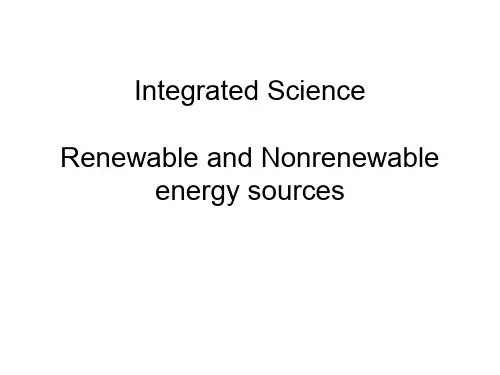再生与不可再生能源讲义(英文)
- 格式:ppt
- 大小:2.59 MB
- 文档页数:57
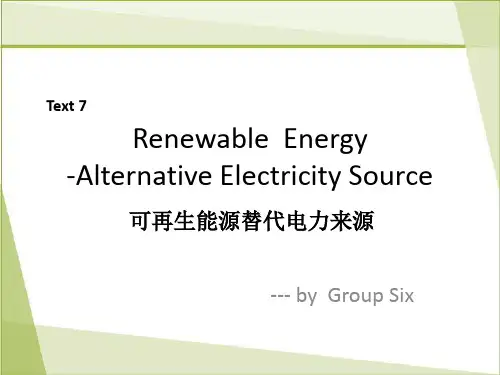
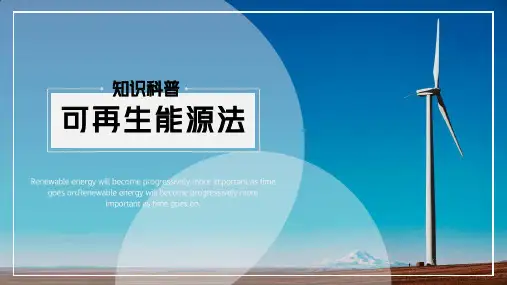

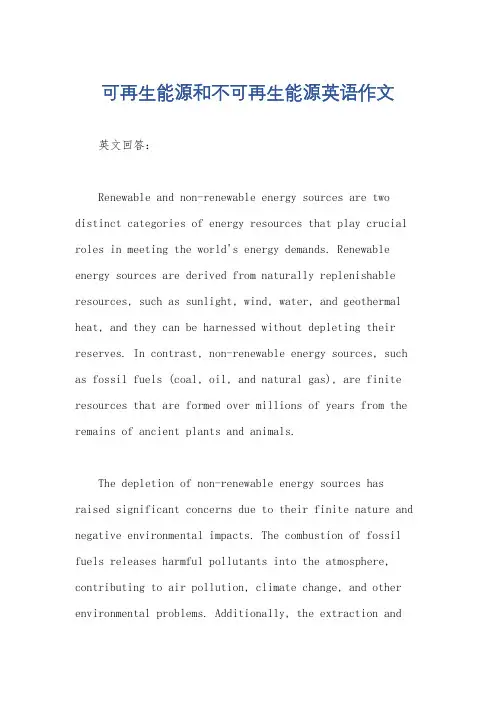
可再生能源和不可再生能源英语作文英文回答:Renewable and non-renewable energy sources are two distinct categories of energy resources that play crucial roles in meeting the world's energy demands. Renewable energy sources are derived from naturally replenishable resources, such as sunlight, wind, water, and geothermal heat, and they can be harnessed without depleting their reserves. In contrast, non-renewable energy sources, such as fossil fuels (coal, oil, and natural gas), are finite resources that are formed over millions of years from the remains of ancient plants and animals.The depletion of non-renewable energy sources has raised significant concerns due to their finite nature and negative environmental impacts. The combustion of fossil fuels releases harmful pollutants into the atmosphere, contributing to air pollution, climate change, and other environmental problems. Additionally, the extraction andproduction of fossil fuels can lead to land degradation, water pollution, and other environmental damage.In contrast, renewable energy sources offer numerous benefits that make them increasingly attractive as sustainable alternatives. These sources are environmentally friendly, producing minimal or zero emissions, thus mitigating air pollution and climate change. Renewable energy is also domestically available in many regions, reducing dependence on foreign energy imports and fostering energy independence. Furthermore, renewable energy technologies are becoming increasingly cost-competitive with traditional fossil fuels, making them economically viable options.Despite the advantages of renewable energy, there are challenges associated with their integration into existing energy systems. Intermittency, the variability in the availability of some renewable sources such as solar and wind, poses challenges to grid stability and requires careful planning and integration with other energy sources. Additionally, the cost of renewable energy technologies canbe higher than that of fossil fuels, although costs have been declining in recent years.To overcome these challenges and accelerate thetransition towards a sustainable energy future, governments, industries, and researchers are actively pursuing advancements in renewable energy technologies and policies. These efforts include investment in research and development, incentives for renewable energy adoption, and the establishment of supportive regulatory frameworks.In conclusion, renewable and non-renewable energy sources represent contrasting approaches to meeting the world's energy needs. While non-renewable energy sources have historically dominated the energy landscape, concerns over their depletion and environmental impacts have prompted a shift towards renewable energy sources. The benefits of renewable energy, including environmental friendliness, reduced emissions, energy independence, and cost-competitiveness, make them increasingly attractive as sustainable alternatives. However, challenges associatedwith intermittency and cost need to be addressed throughtechnological advancements and supportive policies to fully realize the potential of renewable energy in shaping a sustainable energy future.中文回答:可再生能源和不可再生能源。
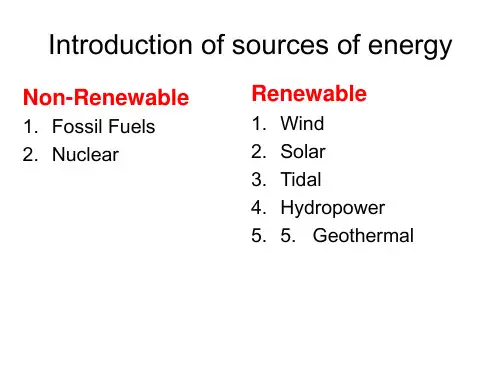
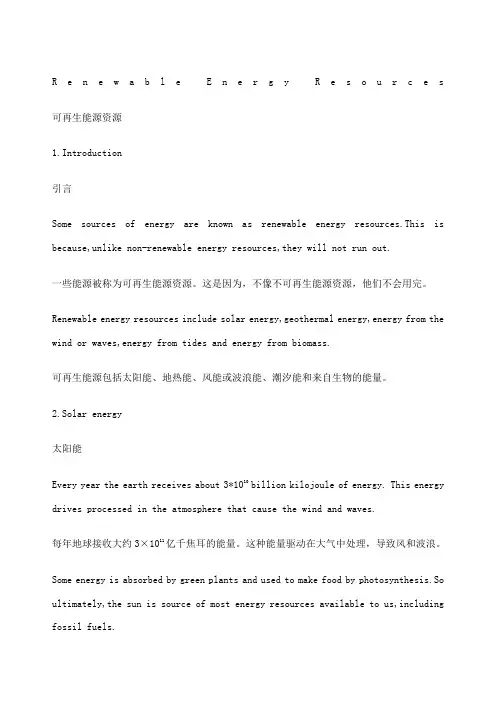
R e n e w a b l e E n e r g y R e s o u r c e s 可再生能源资源1.Introduction引言Some sources of energy are known as renewable energy resources.This is because,unlike non-renewable energy resources,they will not run out.一些能源被称为可再生能源资源。
这是因为,不像不可再生能源资源,他们不会用完。
Renewable energy resources include solar energy,geothermal energy,energy from the wind or waves,energy from tides and energy from biomass.可再生能源包括太阳能、地热能、风能或波浪能、潮汐能和来自生物的能量。
2.Solar energy太阳能Every year the earth receives about 3*1010 billion kilojoule of energy. This energy drives processed in the atmosphere that cause the wind and waves.每年地球接收大约3×1011亿千焦耳的能量。
这种能量驱动在大气中处理,导致风和波浪。
Some energy is absorbed by green plants and used to make food by photosynthesis.So ultimately,the sun is source of most energy resources available to us,including fossil fuels.一些能源被绿色植物吸收,并用来通过光合作用制造食物。
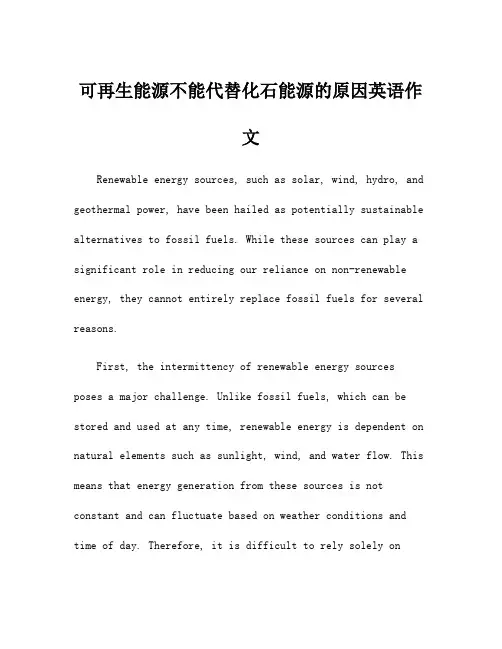
可再生能源不能代替化石能源的原因英语作文Renewable energy sources, such as solar, wind, hydro, and geothermal power, have been hailed as potentially sustainable alternatives to fossil fuels. While these sources can play a significant role in reducing our reliance on non-renewable energy, they cannot entirely replace fossil fuels for several reasons.First, the intermittency of renewable energy sources poses a major challenge. Unlike fossil fuels, which can be stored and used at any time, renewable energy is dependent on natural elements such as sunlight, wind, and water flow. This means that energy generation from these sources is not constant and can fluctuate based on weather conditions and time of day. Therefore, it is difficult to rely solely onrenewable energy to meet the consistent and growing demandfor power.Second, the energy density of renewable sources istypically lower than that of fossil fuels. This means that a larger area of land or water is required to generate the same amount of energy as a smaller area with fossil fuelextraction or power plants. For example, a solar farm may require vast expanses of land to produce the same amount of energy as a single traditional power plant. This has implications for land use, environmental impact, and the overall feasibility of scaling up renewable energy production.Furthermore, the infrastructure required to harness and distribute renewable energy is not yet as developed or widespread as that for fossil fuels. While progress has been made in expanding the capacity for solar and wind power, the existing grid infrastructure is largely designed to accommodate centralized power generation from fossil fuels.Upgrading and expanding this infrastructure to better integrate renewable energy sources requires significant investment and time.In addition, the technology for storing and transporting renewable energy is still evolving. Unlike fossil fuels, which can be easily stored and transported in a variety of ways, many renewable energy sources require specific technologies for storage and transmission. For example, energy storage systems such as batteries for solar and wind power are continuously being developed and improved, but they have not reached the same level of efficiency and cost-effectiveness as traditional fossil fuel storage methods.Finally, the economic and political factors surrounding fossil fuels present additional challenges to the complete replacement of these energy sources. The fossil fuel industry has a long-standing presence and influence in globaleconomies, and there are complexities involved in transitioning away from this established infrastructure.In conclusion, while renewable energy sources offer promise for a more sustainable and environmentally friendly energy future, they cannot fully replace fossil fuels at this time. The intermittency, energy density, infrastructure, technology, and socio-economic factors all contribute to the limitations of renewable energy. As such, a comprehensive approach that includes a mix of energy sources, along with ongoing advancements in technology and policy, will be necessary to address our energy needs while minimizing the impact on the environment.。
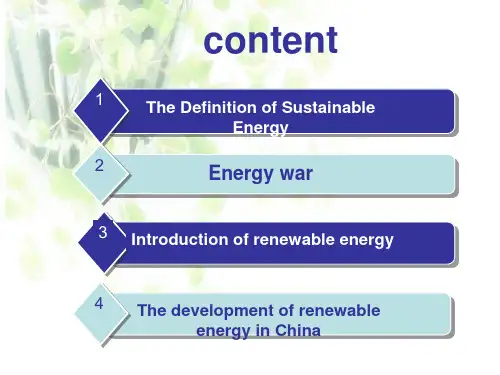
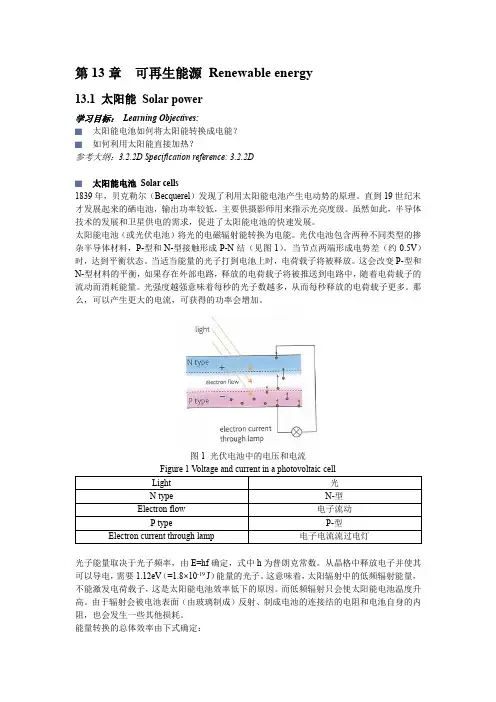
第13章可再生能源Renewable energy13.1 太阳能Solar power学习目标:Learning Objectives:太阳能电池如何将太阳能转换成电能?如何利用太阳能直接加热?参考大纲:3.2.2D Specification reference: 3.2.2D太阳能电池Solar cells1839年,贝克勒尔(Becquerel)发现了利用太阳能电池产生电动势的原理。
直到19世纪末才发展起来的硒电池,输出功率较低,主要供摄影师用来指示光亮度级。
虽然如此,半导体技术的发展和卫星供电的需求,促进了太阳能电池的快速发展。
太阳能电池(或光伏电池)将光的电磁辐射能转换为电能。
光伏电池包含两种不同类型的掺杂半导体材料,P-型和N-型接触形成P-N结(见图1)。
当节点两端形成电势差(约0.5V)时,达到平衡状态。
当适当能量的光子打到电池上时,电荷载子将被释放。
这会改变P-型和N-型材料的平衡,如果存在外部电路,释放的电荷载子将被推送到电路中,随着电荷载子的流动而消耗能量。
光强度越强意味着每秒的光子数越多,从而每秒释放的电荷载子更多。
那么,可以产生更大的电流,可获得的功率会增加。
图1 光伏电池中的电压和电流光子能量取决于光子频率,由E=hf确定,式中h为普朗克常数。
从晶格中释放电子并使其可以导电,需要1.12eV(=1.8×10-19J)能量的光子。
这意味着,太阳辐射中的低频辐射能量,不能激发电荷载子,这是太阳能电池效率低下的原因。
而低频辐射只会使太阳能电池温度升高。
由于辐射会被电池表面(由玻璃制成)反射、制成电池的连接结的电阻和电池自身的内阻,也会发生一些其他损耗。
能量转换的总体效率由下式确定:20世纪50年代,早期的电池由多晶材料制成,其效率仅为6%左右;而现代电池由单晶材料制成,其效率最高可达20%,可轻松达到15%。
太阳能电池面板Solar panels单个太阳能电池可产生的最大电动势为1伏特左右。
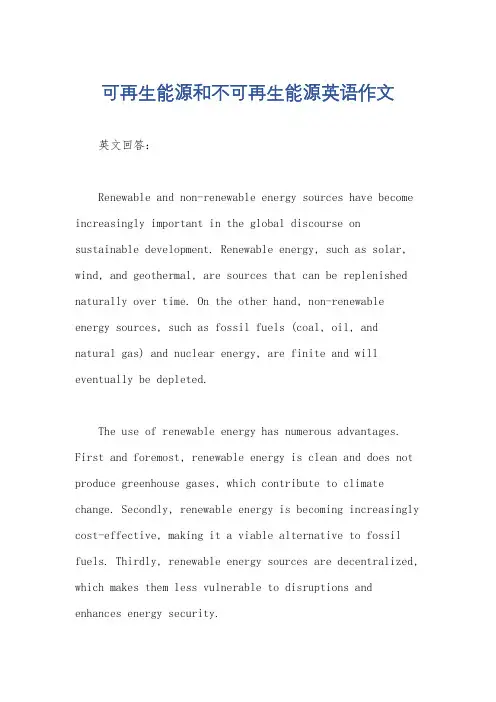
可再生能源和不可再生能源英语作文英文回答:Renewable and non-renewable energy sources have become increasingly important in the global discourse on sustainable development. Renewable energy, such as solar, wind, and geothermal, are sources that can be replenished naturally over time. On the other hand, non-renewable energy sources, such as fossil fuels (coal, oil, and natural gas) and nuclear energy, are finite and will eventually be depleted.The use of renewable energy has numerous advantages. First and foremost, renewable energy is clean and does not produce greenhouse gases, which contribute to climate change. Secondly, renewable energy is becoming increasingly cost-effective, making it a viable alternative to fossil fuels. Thirdly, renewable energy sources are decentralized, which makes them less vulnerable to disruptions and enhances energy security.However, renewable energy also has some limitations. One major challenge is intermittency. Solar and wind energy are not always available, and they can fluctuate significantly depending on weather conditions. This intermittency makes it difficult to rely solely on renewable energy sources to meet baseload demand. Secondly, the development of renewable energy projects often requires large upfront investments, which can be a barrier to entry for some communities.Non-renewable energy sources, on the other hand, are reliable and have high energy density. They have been the backbone of the global energy system for decades. However, the use of non-renewable energy sources comes with significant environmental and health risks. The combustion of fossil fuels releases harmful pollutants into the air, contributing to air pollution and respiratory illnesses. Additionally, the extraction and transportation of fossil fuels can have devastating impacts on ecosystems and biodiversity.Moreover, non-renewable energy sources are finite and will eventually run out. The world's reserves of fossil fuels are rapidly depleting, and it is estimated that we have only a few decades of oil and gas left. This scarcity creates a sense of urgency to transition to renewable energy sources.In conclusion, both renewable and non-renewable energy sources have their own advantages and disadvantages. Renewable energy is clean, sustainable, and becoming increasingly cost-effective. However, it is intermittent and requires large upfront investments. Non-renewable energy sources are reliable and have high energy density, but they are polluting, finite, and contribute to climate change. As the world faces the challenges of climate change and energy security, it is imperative to transition to a more sustainable energy system that relies primarily on renewable energy sources.中文回答:可再生能源和不可再生能源。
